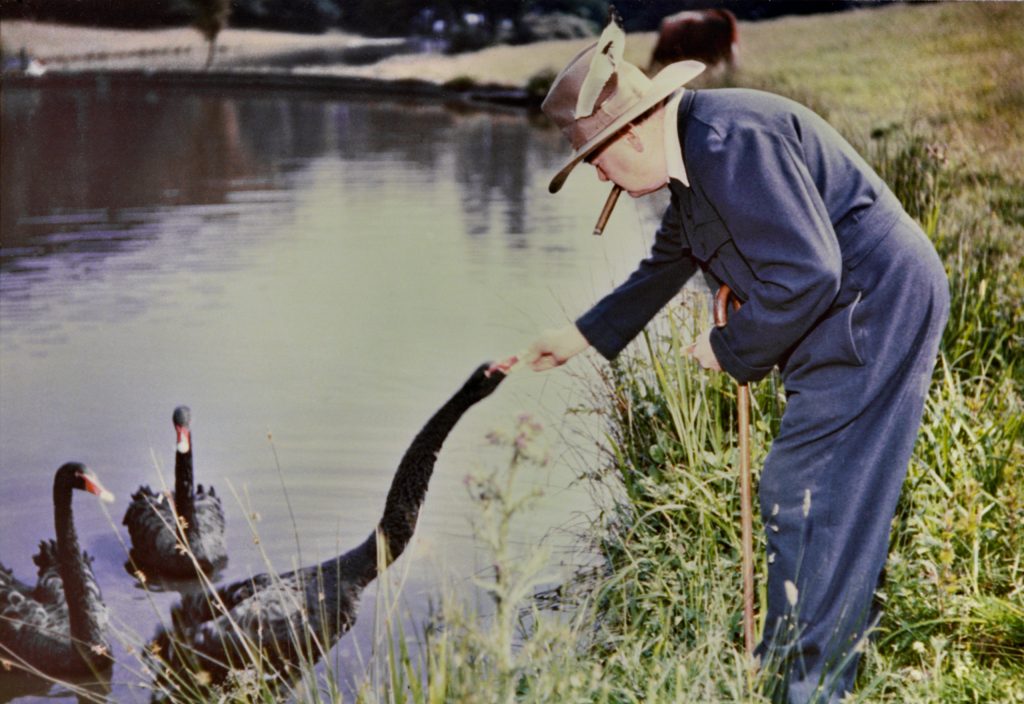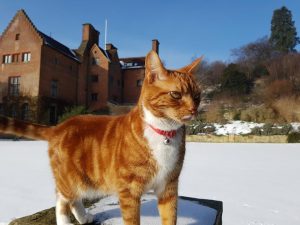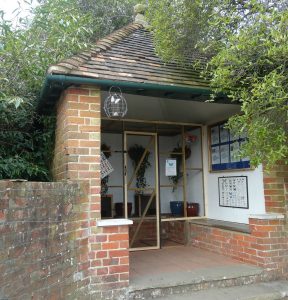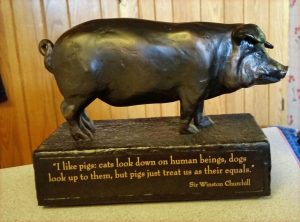
Finest Hour 183
Working in Winston’s Animal Kingdom

Churchill feeding the swans at Chartwell credit: Alamy.com
June 1, 2019
Finest Hour 183, First Quarter 2019
Page 11
By Piers Brendon
Piers Brendon is former Keeper of the Churchill Archives Centre and author of Churchill’s Bestiary: His Life Through Animals (2018). See extract page 50.
As an Oxford undergraduate Lord Randolph Churchill, Winston’s father, kept his own pack of harriers, nine couple of hounds supervised by a whip dressed in livery. At Blenheim Palace, where Winston was born in 1874, twenty gamekeepers wearing brown breeches, green velvet coats with brass buttons and black billycock hats, assisted by an army of loaders and beaters, ensured that the Duke of Marlborough’s field sports, often attended by royalty, were conducted like military operations. The immense stable block, housing carriage horses as well as a score of magnificent hunters, was run by a platoon of grooms, and in the great house some eighty servants were on hand to cope with a large dog population. Gladys—wife of Winston’s cousin Sunny, ninth Duke of Marlborough—was said to walk around on a “moving carpet of King Charles spaniels,” and she bid fair to turn the palace into a kennel.1 In short, Winston was brought up in symbiosis with animals, both wild and tame, and with the people who managed their lives.
Like other members of the Victorian upper class, Churchill had no difficulty in reconciling his fondness for blood sports with his affection for creatures great and small. Hunting, shooting, and fishing were intrinsic to aristocratic life at the time, activities deemed essential to a wholesome rural existence, part of the natural order of things. At the same time pets were cherished with sentimental devotion, and kindness to animals was regarded—as Churchill himself said it should be—as a mark and duty of civilisation. Where he was unusual was in his passionate engagement with the animal kingdom.
Churchill revelled in the thrill of the chase, saying that fox-hunting was the greatest pleasure in the world and later delighting in hunting big game in Africa and wild boar in France. Yet at Chartwell, his home in Kent, he surrounded himself with domestic creatures (including pet foxes) who became members of his extended family. He doted on them extravagantly, investing them with human characteristics. They permeated his mind, imbuing his conversation and his rhetoric with animal imagery. He identified with them, talked to them, even wrote them letters. They became bit-part players in the psychodrama of his life. Hesitating when his wife Clementine urged him to get on with carving a large roast chicken on the dining table, he said in a voice fraught with emotion: “I’m just wondering if this is Ethel.”2

2025 International Churchill Conference
The Keepers
In his association with animals as in other occupations (politics, writing, painting, bricklaying, and so on), Churchill relied on a large cohort of assistants. Among them were his personal staff, valets such as Norman McGowan who helped look after his poodle Rufus, bodyguards such as Eddie Murray who ferried him around his farms, secretaries such as Jane Portal on whom his budgerigar Toby liked to perch, and Chartwell’s general factotum Grace Hamblin, who recalled that Churchill “was never more pleased than when my father fixed a wire brush to a long stick and presented him with it as a back scratcher for his pigs.”3 Nor did Churchill stint himself on outdoor help employing grooms for his polo ponies; trainers (notably Walter Nightingall) for his race-horses; gardeners to attend to his butterflies, fish, and wildfowl; chauffeurs to transport his dogs; and agricultural workers to care for his cattle, sheep, and poultry—the last grandly housed in Chickenham Palace, itself surrounded by a mud patch known as Chickenham Palace Gardens.
With such employees he was generally benign and fair, though prone to impatience and sometimes explosive. In 1926, during one of his doomed economy drives, he decided to give up producing milk, but he took trouble to find another job for his redundant cowman. He repudiated, however, a subsequent Chartwell cowman who had loudly damned a reluctant breeder called Lullenden Helen, which Churchill had bought from his old comrade General Sir Ian Hamilton. To Hamilton he wrote:
I am vexed that one of my men should have been so churlish. I value most highly your beautiful cow. She has adorned our pastures during the summer, and if only her family affairs can be satisfactorily adjusted will be an unfailing source of interest in the coming year.4
The unmannerly cowman did not impair their friendship, and in 1943 Hamilton invited Churchill to see a new-born addition to his Belted Galloway herd, christened Winnie. “How lovely about the calf,” the Prime Minister replied. “Alas, I cannot make any plans, being tied by the leg and both ears.”5
Give Us the Tools
To assist with his multifarious animal enterprises Churchill recruited unskilled labour wherever he could find it. During a Mediterranean cruise aboard the Admiralty yacht Enchantress in 1912, he deployed Admirals Beatty and Masterton-Smith to act as beaters in a lizard hunt at Paestum, insisting, when their strategy proved defective, that there “is a science in catching lizards and we must master it.”6 “I have watched him,” wrote Diana Cooper, “mobilize tired notables at a house party to seek a lost poodle in twilight.”7 He drafted his nephew Johnny to help repel a pre-war invasion of his lake by Embden geese, “horrible Nazis” for which the gardener was told to make a “concentration camp.”8
After the war Churchill used two German POWs to clear the ground around the lake (emptied because it might have identified Chartwell to the Luftwaffe) and ponds so that they could be restocked with fish. And when his golden orfe became infected with a fungal disease, he marshalled members of his family as well as a posse of workmen to help with catching and chemically cleaning the fish individually. Supervising this onerous task in person, Churchill complained that it was going too slowly. Largely to blame were the ancient nets, which kept breaking, and he was amused when one of his minions said: “Give us the tools and we’ll finish the job.”9
Les Poissons

Churchill also enlisted experts to give advice and help with his fish and other animals. Stanley Plater, who supplied ornamental fish to Harrods, oversaw the stocking and breeding of goldfish and golden orfe before the war. Churchill greeted the new arrivals with delight (“I told them to eat all that they wish”), and in September 1939 he agreed to Plater’s request to afford Harrods’ stock of fish, which would otherwise not survive, sanctuary at Chartwell for the duration.10 Plater delivered a glittering shoal, mostly different kinds of goldfish with colourful names: orandas, celestials, calicoes, veiltails, golden comets, and golden orfe. He was permitted to publicise the whole operation, and he reported that Churchill called some of the fish by name. As Prime Minister, Churchill could only pay them rare visits, but about a fortnight before D-Day he instructed Plater to take a canoe onto the middle pool on a hot day “and look at the fish.”11 Plater reported that they were doing well despite lack of nourishment, but within a year predators, probably otters, had virtually wiped them out. Much upset, Churchill suspected gypsies and called in Scotland Yard, which failed to find the culprits.
Churchill determined to take better care of the postwar inhabitants of his waters. Giving elaborate orders for their protection, he instructed Chartwell’s head gardener to “keep a sharp look-out for herons, both at the lake and in the garden pool, and if any appear drive them away.”12 Despite the prevailing austerity Churchill also insisted that the fish should be well fed, and he evidently became disenchanted with Plater on account of the meal-worms he provided, telling him indignantly: “The worms, which cost more than caviar, are rotting.”13 Instead Churchill turned to another ex-Harrods man, Douglas Parbury, who supplied fish in the bright hues Churchill loved, among them red higoi carp and multi-coloured shubunkins. Parbury also gave guidance about breeding and nurture, warned against the use of DDT, and by a process of segregation forwarded Churchill’s campaign to stamp out piscine cannibalism in his pools. Evidently Parbury confirmed his views about diet. Thus Churchill fed his fish on “high-class maggots” specially dispatched from Yorkshire in fibre-packed tins at a cost of 22 shillings and sixpence a week.14 “Aristocratic maggots, these are,” he liked to say. “Look how well the fish are doing on them.”15
Lepidopterist

Churchill had been fascinated by butterflies as a schoolboy “bug-hunter,” as a subaltern collector, and as a mature admirer of their fluttering beauty. After the war he solicited the help of a commercial entomologist to help breed them at Chartwell. L. Hugh Newman ran a butterfly farm at Bexley, and in the spring of 1946 Churchill took him on a stroll round his grounds and asked him “to give me the means to multiply the common butterflies in my garden so that they will fly out among the flowers.”16 Churchill expatiated about the project with his usual magniloquence, and Newman was not sure “if he was serious when he suggested laying on ‘fountains of honey and water’ in the rose garden to feed the butterflies which I was to release.”17
These may have been fantasy fountains, but, with advice from Newman about protecting pupae from mice and earwigs, Churchill did convert an old summerhouse into a butterfly nursery. In June 1947 Newman brought 500 half-grown peacock caterpillars to Chartwell, telling Churchill: “Unlike the swallowtails, which I consider a ‘luxury’ butterfly, peacocks hibernate and you will see them again, or rather a percentage of them, next spring.”18 Newman supplied other varieties with the kind of picturesque names that appealed to Churchill—white admirals, scarlet tigers, green-veined whites, speckled woods, painted ladies—as well as privet and elephant hawk-moth caterpillars. Amid protests from the head gardener, Newman also saw to the planting of vegetation attractive to butterflies: buddleia, fennel, thistles, and nettles.
Newman, however, was an enthusiast and a populariser (who later helped to present “Nature Parliament” on BBC Radio’s Children’s Hour) rather than a qualified lepidopterist, and his initiatives were not always a success. Aspiring to introduce alien varieties of butterfly, he employed seductive military metaphors to win Churchill’s support: Chartwell should become “the new headquarters of the black-veined white, as Kent was previously its last [English] stronghold.”19 Alas, imports such as the rare yellow-and-black swallowtail were unsuited to their new habitat, and they all died. Thanks to Newman, therefore, Churchill incurred criticism: he could defeat the Nazis, it was said, but he “could not play God with butterflies.”20 Of course, he had no such intention, and, as it happens, climate change is now making the establishment of varieties such as the black-veined white possible at Chartwell, where the National Trust continues his work of swathing the gardens in butterflies. So, as one authority recently said, Churchill might “simply have been seven decades ahead of his time.”21
Regent’s Park
London Zoo in Regent’s Park had always been a magnet to Churchill, and he solicited its help and that of its staff in many of his animal endeavours. Wanting his quarrelsome black swans to live together harmoniously like geese, he drafted John Yealland, the Zoo’s distinguished Curator of Birds, in a vain attempt to bring avian peace to his lake. He invoked the Zoo’s aid over the spawning of his fish, planting waterweeds in shallow shingle to offer them, he told Clementine, “attractive glades for their approaching honeymoon.”22 The benefits were not all one-sided: Churchill eventually sent most of his prized collection of tropical fish to Regent’s Park, where the Curator of the Aquarium expected a substantial increase in visitors as a result. The Zoo also housed large animals that Churchill was given, which also proved a draw: his lion Rota, his leopard Sheba, and his two white kangaroos, Digger and Matilda.
 In addition to being involved in such transactions, the Zoo’s superintendent Dr Geoffrey Vevers participated in Churchill’s effort to conciliate Australian opinion after the fall of Singapore by means of what might be called platypus diplomacy. In one of the strangest of secret wartime sagas, Churchill persuaded the Australian government to send London Zoo a duck-billed platypus. Vevers planned to install its “platypussary” in a corner of the Aquarium hitherto occupied by a manatee and to advertise its arrival by appealing to the public to provide 100,000 worms to feed it over the winter. Churchill offered to make a personal contribution of £50 to cater for the platypus’s “extra needs.”23 Unfortunately, however, the sensitive creature died during a mid-Atlantic duel between its ship and a U-Boat. So Churchill’s propaganda coup was thwarted and Vevers was denied the chance to exhibit “one of the most primitive of all existing mammals.”24
In addition to being involved in such transactions, the Zoo’s superintendent Dr Geoffrey Vevers participated in Churchill’s effort to conciliate Australian opinion after the fall of Singapore by means of what might be called platypus diplomacy. In one of the strangest of secret wartime sagas, Churchill persuaded the Australian government to send London Zoo a duck-billed platypus. Vevers planned to install its “platypussary” in a corner of the Aquarium hitherto occupied by a manatee and to advertise its arrival by appealing to the public to provide 100,000 worms to feed it over the winter. Churchill offered to make a personal contribution of £50 to cater for the platypus’s “extra needs.”23 Unfortunately, however, the sensitive creature died during a mid-Atlantic duel between its ship and a U-Boat. So Churchill’s propaganda coup was thwarted and Vevers was denied the chance to exhibit “one of the most primitive of all existing mammals.”24
The Happy Zoo
Like a medieval monarch Churchill relied on his entourage to undertake the humblest of tasks, even killing insects—he once asked his secretary to summon his valet to wring a troublesome fly’s “bloody neck.”25 At least two members of staff were required to service Churchill’s budgie Toby. Muriel Thomson, who nursed the aged titan, recorded that her duties included waking the bird each morning, placing him near Churchill’s chair in the dining room and putting him to bed at night. Roy Howells, who also looked after Churchill at the same time, said that ensuring Toby’s supply of seed, grit, sandpaper, and cuttlefish on overseas journeys was almost as important as ordering his master’s cigars. Churchill’s secretaries acted as supernumerary keepers in what his daughter Mary designated “THE HAPPY ZOO, CHARTWELL.”26
Churchill’s staff conducted his animals’ correspondence, sending him Christmas cards from his cat Nelson, acknowledging telegrams from his lion Rota, and superintending the “marriage” of his poodle Rufus. This included writing (doubtless at Churchill’s dictation) a billet doux marked “VERY PRIVATE” from Rufus the poodle to his intended, Jennifer, arranging a tryst in Mayfair at Miss Bella Lobban’s “very nice kennels.”27 Churchill’s secretaries, as hard pressed as everyone else he engaged to advance his Stakhanovite enterprises, also had to fend off well-wishers who threatened to deluge him with pets. In August 1943 Kathleen Hill told Grace Hamblin, “It hurts me to turn down so many cat offers!”28 But without such protection, Churchill exclaimed, “I could literally be petted to death.”29
Endnotes
1. Anita Leslie, The Gilt and the Gingerbread (London: Hutchinson, 1981), p. 134.
2. Churchill Archive Centre (hereafter cited CAC), NEMO 3/1/70.
3. CAC, HAMB 1/1.
4. CAC, CHAR 1/286/40, 30 October 1936.
5. CAC, CHAR 2/466, 11 October 1943.
6. Violet Bonham Carter, Winston Churchill as I Knew Him (New York: Harcourt Brace, 1965), p. 264.
7. Diana Cooper, “The Lion’s Heart,” in Atlantic Monthly 215, no. 3 (March 1965), p. 59.
8. John S. Churchill, Crowded Canvas: The Memoirs of John Spencer Churchill (London: Odhams, 1961), p. 151.
9. Edmund Murray, Churchill’s Bodyguard (London: W. H. Allen, 1987), p. 129.
10. Mary Soames, ed., Speaking for Themselves: The Personal Letters of Winston and Clementine Churchill (London: Doubleday, 1998), p. 422.
11. CAC, CHAR, 1/383/16.
12. CAC, CHUR 1/130/90, 11 November 1945.
13. CAC, CHWL 4/4, Churchill to Plater, 28 April 1948.
14. CAC, CHAR 1/394/273, 26 May 1948.
15. Walter Graebner, My Dear Mr Churchill (London: Michael Joseph, 1965), p. 103.
16. CAC, CHUR 1/130/9, Churchill to Newman, 13 June 1946.
17. L. Hugh Newman, Butterfly Farmer (London: Phoenix House, 1953), p. 164.
18. CAC, CHWL 8, Newman to Churchill, 20 June 1947.
19. CAC, CHUR 1/20/214, Newman to Churchill, 30 April 1949. Newman’s article was published in The Entomologist LXXXII (June 1949), p. 140.
20. Patrick Barkham, The Butterfly Isles: A Summer in Search of our Emperors and Admirals (London: Granta, 2010), p. 219.
21. Guardian, 7 April 2018.
22. Soames, p. 581.
23. CAC, CHUR 1/58A–B/291.
24. CAC, CHUR 1/58A–B/285.
25. Andrew Roberts, Churchill: Walking with Destiny (London: Allen Lane, 2018), p. 11.
26. CAC, CHAR 1/344/4. This address was printed on Mary’s writing paper.
27. CAC, CHUR 1/59/143.
28. CAC, CHAR 2/472A–B.
Subscribe
WANT MORE?
Get the Churchill Bulletin delivered to your inbox once a month.



